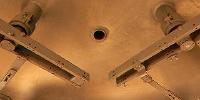
Vacuum Chamber - Cámara de Vacío
Llano del Hato, Mérida, Venezuela
march 21th, 10 a.m. local time.
© 2007 Gerardo A. Sanchez, All Rights Reserved.
Atmosphere is the general name for a layer of gases that surround a celestial body of sufficient mass to hold them. The gases are attracted by the gravity of the body, and are retained for a longer duration if the gravity is high and the atmospheric temperature is low. But ... is it possible to remove the atmosphere temporarily?
Almost: There is a neat piece of engineering called a Vacuum Chamber which can mimic an atmosphere-less world. This chamber removes all traces of atmospheric gases that could be found in it, reducing the inside pressure to less than 100.000.000 times that of the external pressure.
This chamber is used to restore the aluminium coating on the main mirrors at the National Observatory in Venezuela. Due to dust, humidity and oxidation the mirrors reflectivity is lost, and once every two years or so the aluminium coating is removed and a new one applied.
The chamber is two meters in diameter. It takes about two hours for several vacuum pumps to create such an environment. Three tungsten bars are used to burn a small amount of pure aluminium. Due to the low pressure inside the chamber the aluminium is deposited in a fine even layer over the glass. During the process the round plate is spinning which helps to produce a homogeneous reflective surface.
The round plate and the triangular plate on the upper part of the chamber are also used as electrodes. A high electric current is applied over them to create a magnetic field, which draws small particles (as a light dots) from the lower round plate to the upper electrodes cleaning the glasses. This process, called efluvium, creates a nice blue light that can be observed through the windows on the chamber.
After several hours of work the "new" mirrors are taken out from the chamber and put back again inside the telescopes.
This panorama shows the chamber a few minutes before the process of burning the aluminium began; there are nine small mirrors ready to get new reflective layers. Can you see them all? (the answer is in this picture!)
Other Pictures:
- One meter mirror after getting a new aluminium layer
- Taken out from the chamber
- From the basement to the dome top, where the telescope is
- One tonne mirror hanging 10 meters and swinging over my head!!
- Workers after finishing a very good job
Lat: 8° 47' 18" N
Long: 71° 53' 12" W
Elevation: 3600 masl
Precision is: Unknown / Undeclared.
Atmósfera es el nombre que se le da a la capa de gases que rodea un cuerpo celeste. Los gases son atraídos por la fuerza de gravedad y su permanencia depende del campo gravitatorio de dicho cuerpo y de la temperatura que estos gases alcancen. Pero: ¿Es posible remover estos gases temporalmente aunque sea en un pequeño lugar? Existe un interesante equipo de ingeniería llamado "Cámara de Vacío" el cual puede remover casi todos los gases de su interior disminuyendo la presión a un valor 100.000.000 veces menor que la presión externa.
La cámara mostrada aquí es utilizada para reponer la capa de aluminio de los espejos del Observatorio Nacional de Llano del Hato en Venezuela. Debido al polvo, la humedad y la oxidación la capa reflectiva de los espejos va perdiendo sus condiciones con el paso del tiempo. Es por esto que al menos una vez cada dos años esta capa es removida y una nueva es aplicada.
La cámara de vacío tiene dos metros de diámetro y se necesitan varias horas para remover todos los gases de su interior a través de varias bombas de vacío. Tres barras de tungsteno son utilizadas para fundir una pequeña cantidad de aluminio el cual se vaporiza. Debido a la baja presión existente en el interior de la cámara el aluminio se deposita como una fina y homogénea capa reflectiva. El plato inferior se hace girar durante el proceso para ayudar en la uniformidad de la deposición.
Esta placa giratoria junto con la placa triangular de la parte superior también son utilizadas como electrodos. Aplicando una corriente de alto amperaje se crea un campo magnético que atrae las partículas (vistas como pequeños puntos luminosos) de la placa inferior ayudando a limpiar la superficie de los vidrios. Este proceso, llamado efluvio, puede ser visto desde el exterior como un interesante camino de luz azul.
Después de varias horas de trabajo los "nuevos" espejos están listos y son removidos desde el interior de la cámara para ser instalados nuevamente en los telescopios.
Esta panorámica muestra el interior de la cámara unos minutos antes de que el aluminio sea fundido. Hay nueve pequeños espejos girando en la placa inferior ¿Podría identificarlos todos? (la respuesta está en esta fotografía).
Otras fotografías:
- Espejo de un metro después de obtener una nueva capa de aluminio
- Espejo al ser removido del interior de la cámara de vacío
- Desde el sotano al tope del domo donde se encuentra el telescopio
- ¡Espejo de una tonelada colgando 10 metros sobre mi cabeza!
- Trabajadores al culminar un excelente trabajo


 Tap or click the zoom icon in the bottom right corner of the picture to switch between in-page and fullscreen view
Tap or click the zoom icon in the bottom right corner of the picture to switch between in-page and fullscreen view